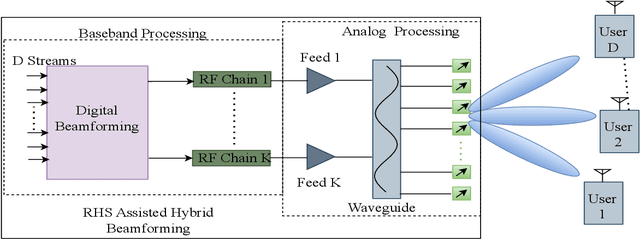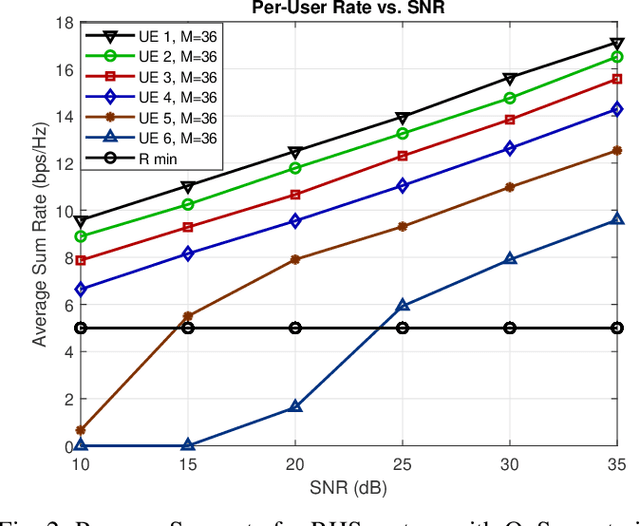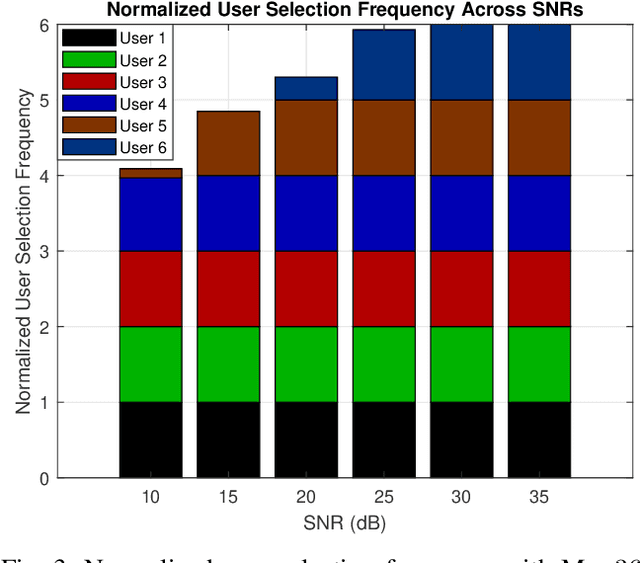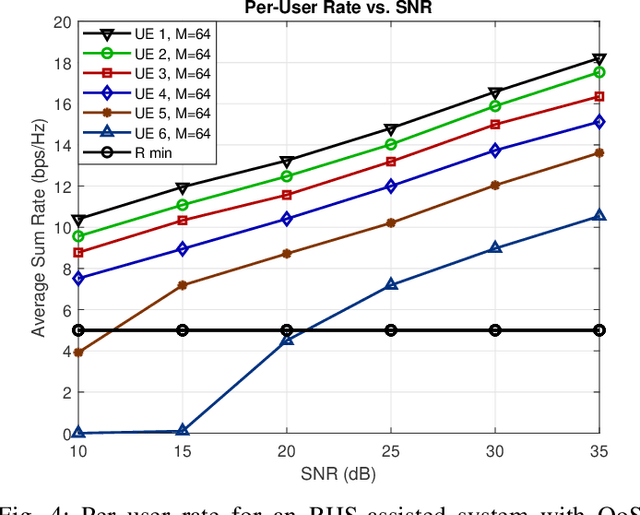Chandan Kumar Sheemar
Multilayer Non-Terrestrial Networks with Spectrum Access aided by Beyond-Diagonal RIS
Oct 06, 2025Abstract:In this work, we study a multi-user NTN in which a satellite serves as the primary network and a high-altitude platform station (HAPS) operates as the secondary network, acting as a cognitive radio. To reduce the cost, complexity, and power consumption of conventional antenna arrays, we equip the HAPS with a transmissive BD-RIS antenna front end. We then formulate a joint optimization problem for the BD-RIS phase response and the HAPS transmit power allocation under strict per-user interference temperature constraints. To tackle the resulting highly nonconvex problem, we propose an alternating-optimization framework: the power-allocation subproblem admits a closed-form, water-filling-type solution derived from the Karush-Kuhn-Tucker (KKT) conditions, while the BD-RIS configuration is refined via Riemannian manifold optimization. Simulation results show significant gains in data rate and interference suppression over diagonal RIS-assisted benchmarks, establishing BD-RIS as a promising enabler for future multilayer NTNs.
Multi-Active RIS-Assisted THz Cell-Free Systems: Spectral and Energy Efficiency Tradeoff
May 13, 2025Abstract:Reconfigurable intelligent surfaces (RISs) and cell-free massive multiple-input multiple-output (CF-mMIMO) are effective solutions for mitigating large path loss and inter-cell interference in terahertz (THz) systems. However, passive RISs are notably limited from double-fading attenuation, motivating the use of active RISs with power amplification to improve signal strength. In this paper, we investigate a multi-active RIS-aided wideband CF-mMIMO system for THz communications, considering low-resolution digital-to-analog converters (DACs) to optimize the spectral efficiency (SE)-energy efficiency (EE) tradeoff by adjusting precoding vectors and reflection coefficient response of the RISs, subject to power and minimum desirable per-user rate constraints. This leads to a highly complex and non-convex, multi-objective and fractional optimization problem. To solve it, we propose a tailored quadratic transformation to manage the fractional form. This allows decomposition into two subproblems, which are iteratively solved via a successive convex approximation algorithm to optimize the precoding vectors and active RIS reflection coefficients until convergence. Numerical results demonstrate that the proposed active RIS-aided CF-mMIMO system effectively addresses propagation loss and limited scattering in THz communication, achieving superior EE and SE compared to conventional passive RIS across diverse scenarios. Furthermore, the integration of low-resolution DACs shows significant improvement in EE while preserving satisfactory communication performance.
Minimum Mean Squared Error Holographic Beamforming for Sum-Rate Maximization
Mar 21, 2025



Abstract:This paper studies the problem of hybrid holographic beamforming for sum-rate maximization in a communication system assisted by a reconfigurable holographic surface. Existing methodologies predominantly rely on gradient-based or approximation techniques necessitating iterative optimization for each update of the holographic response, which imposes substantial computational overhead. To address these limitations, we establish a mathematical relationship between the mean squared error (MSE) criterion and the holographic response of the RHS to enable alternating optimization based on the minimum MSE (MMSE). Our analysis demonstrates that this relationship exhibits a quadratic dependency on each element of the holographic beamformer. Exploiting this property, we derive closed-form optimal expressions for updating the holographic beamforming weights. Our complexity analysis indicates that the proposed approach exhibits only linear complexity in terms of the RHS size, thus, ensuring scalability for large-scale deployments. The presented simulation results validate the effectiveness of our MMSE-based holographic approach, providing useful insights.
Enhancing Physical Layer Security in Cognitive Radio-Enabled NTNs with Beyond Diagonal RIS
Mar 20, 2025Abstract:Beyond diagonal reconfigurable intelligent surfaces (BD-RIS) have emerged as a transformative technology for enhancing wireless communication by intelligently manipulating the propagation environment. This paper explores the potential of BD-RIS in improving cognitive radio enabled multilayer non-terrestrial networks (NTNs). It is assumed that a high-altitude platform station (HAPS) has set up the primary network, while an uncrewed aerial vehicle (UAV) establishes the secondary network in the HAPS footprint. We formulate a joint optimization problem to maximize the secrecy rate by optimizing BD-RIS phase shifts and the secondary transmitter power allocation while controlling the interference temperature from the secondary network to the primary network. To solve this problem efficiently, we decouple the original problem into two sub-problems, which are solved iteratively by relying on alternating optimization. Simulation results demonstrate the effectiveness of BD-RIS in cognitive radio-enabled multilayer NTNs to accommodate the secondary network while satisfying the constraints imposed from the primary network.
Beyond Diagonal RIS Enhanced Cognitive Radio Enabled Multilayer Non-Terrestrial Networks
Mar 13, 2025Abstract:Beyond diagonal reconfigurable intelligent surfaces (BD-RIS) have emerged as a transformative technology for enhancing wireless communication by intelligently manipulating the propagation environment. Its interconnected elements offer enhanced control over signal redirection, making it a promising solution for integrated terrestrial and non-terrestrial networks (NTNs). This paper explores the potential of BD-RIS in improving cognitive radio enabled multilayer non-terrestrial networks. We formulate a joint optimization problem that maximizes the achievable spectral efficiency by optimizing BD-RIS phase shifts and secondary transmitter power allocation while controlling the interference temperature from the secondary network to the primary network. To solve this problem efficiently, we decouple the original problem and propose a novel solution based on an alternating optimization approach. Simulation results demonstrate the effectiveness of BD-RIS in cognitive radio enabled multilayer NTNs.
Survey on Beyond Diagonal RIS Enabled 6G Wireless Networks: Fundamentals, Recent Advances, and Challenges
Mar 11, 2025Abstract:Beyond Diagonal Reconfigurable Intelligent Surfaces (BD-RIS) represent a groundbreaking innovation in sixth-generation (6G) wireless networks, enabling unprecedented control over wireless propagation environments compared to conventional diagonal RIS (D-RIS). This survey provides a comprehensive analysis of BD-RIS, detailing its architectures, operational principles, and mathematical modeling while highlighting its performance benefits. BD-RIS classifications, including single-connected, fully-connected, and group-connected architectures, and their reflective, transmissive, hybrid, and multi-sector operating modes are examined. Recent advances in BD-RIS-enabled 6G networks are reviewed, focusing on critical areas such as channel estimation, sum-rate and spectral efficiency optimization, energy efficiency enhancement, and security. The survey identifies fundamental challenges in BD-RIS research, including hardware design limitations, adaptive channel estimation, and the impact of non-ideal hardware effects. Future research directions for BD-RIS are proposed, emphasizing the integration of artificial intelligence and machine learning (AI/ML), joint optimization of communication and sensing, and enhanced physical layer security (PLS). This study concludes by underscoring BD-RIS's transformative potential to redefine 6G wireless networks, offering valuable insights and lessons for future research and development.
Secrecy Rate Maximization for 6G Reconfigurable Holographic Surfaces Assisted Systems
Mar 03, 2025Abstract:Reconfigurable holographic surfaces (RHS) have emerged as a transformative material technology, enabling dynamic control of electromagnetic waves to generate versatile holographic beam patterns. This paper addresses the problem of secrecy rate maximization for an RHS-assisted systems by joint designing the digital beamforming, artificial noise (AN), and the analog holographic beamforming. However, such a problem results to be non-convex and challenging. Therefore, to solve it, a novel alternating optimization algorithm based on the majorization-maximization (MM) framework for RHS-assisted systems is proposed, which rely on surrogate functions to facilitate efficient and reliable optimization. In the proposed approach, digital beamforming design ensures directed signal power toward the legitimate user while minimizing leakage to the unintended receiver. The AN generation method projects noise into the null space of the legitimate user channel, aligning it with the unintended receiver channel to degrade its signal quality. Finally, the holographic beamforming weights are optimized to refine the wavefronts for enhanced secrecy rate performance Simulation results validate the effectiveness of the proposed framework, demonstrating significant improvements in secrecy rate compared to the benchmark method.
Joint Beamforming and 3D Location Optimization for Multi-User Holographic UAV Communications
Feb 24, 2025Abstract:This paper pioneers the field of multi-user holographic unmanned aerial vehicle (UAV) communications, laying a solid foundation for future innovations in next-generation aerial wireless networks. The study focuses on the challenging problem of jointly optimizing hybrid holographic beamforming and 3D UAV positioning in scenarios where the UAV is equipped with a reconfigurable holographic surface (RHS) instead of conventional phased array antennas. Using the unique capabilities of RHSs, the system dynamically adjusts both the position of the UAV and its hybrid beamforming properties to maximize the sum rate of the network. To address this complex optimization problem, we propose an iterative algorithm combining zero-forcing digital beamforming and a gradient ascent approach for the holographic patterns and the 3D position optimization, while ensuring practical feasibility constraints. The algorithm is designed to effectively balance the trade-offs between power, beamforming, and UAV trajectory constraints, enabling adaptive and efficient communications, while assuring a monotonic increase in the sum-rate performance. Our numerical investigations demonstrate that the significant performance improvements with the proposed approach over the benchmark methods, showcasing enhanced sum rate and system adaptability under varying conditions.
Joint Holographic Beamforming and User Scheduling with Individual QoS Constraints
Feb 24, 2025



Abstract:Reconfigurable holographic surfaces (RHS) have emerged as a transformative material technology, enabling dynamic control of electromagnetic waves to generate versatile holographic beam patterns. This paper addresses the problem of joint hybrid holographic beamforming and user scheduling under per-user minimum quality-of-service (QoS) constraints, a critical challenge in resource-constrained networks. However, such a problem results in mixed-integer non-convex optimization, making it difficult to identify feasible solutions efficiently. To overcome this challenge, we propose a novel iterative optimization framework that jointly solves the problem to maximize the RHS-assisted network sum-rate, efficiently managing holographic beamforming patterns, dynamically scheduling users, and ensuring the minimum QoS requirements for each scheduled user. The proposed framework relies on zero-forcing digital beamforming, gradient-ascent-based holographic beamformer optimization, and a greedy user selection principle. Our extensive simulation results validate the effectiveness of the proposed scheme, demonstrating their superior performance compared to the benchmark algorithms in terms of sum-rate performance, while meeting the minimum per-user QoS constraints
Holographic Joint Communications and Sensing With Cramer-Rao Bounds
Feb 21, 2025Abstract:Joint Communication and Sensing (JCAS) technology facilitates the seamless integration of communication and sensing functionalities within a unified framework, enhancing spectral efficiency, reducing hardware complexity, and enabling simultaneous data transmission and environmental perception. This paper explores the potential of holographic JCAS systems by leveraging reconfigurable holographic surfaces (RHS) to achieve high-resolution hybrid holographic beamforming while simultaneously sensing the environment. As the holographic transceivers are governed by arbitrary antenna spacing, we first derive exact Cram\'er-Rao Bounds (CRBs) for azimuth and elevation angles to rigorously characterize the three-dimensional (3D) sensing accuracy. To optimize the system performance, we propose a novel weighted multi-objective problem formulation that aims to simultaneously maximize the communication rate and minimize the CRBs. However, this formulation is highly non-convex due to the inverse dependence of the CRB on the optimization variables, making the solution extremely challenging. To address this, we propose a novel algorithmic framework based on the Majorization-Maximization (MM) principle, employing alternating optimization to efficiently solve the problem. The proposed method relies on the closed-form surrogate functions that majorize the original objective derived herein, enabling tractable optimization. Simulation results are presented to validate the effectiveness of the proposed framework under diverse system configurations, demonstrating its potential for next-generation holographic JCAS systems.
 Add to Chrome
Add to Chrome Add to Firefox
Add to Firefox Add to Edge
Add to Edge